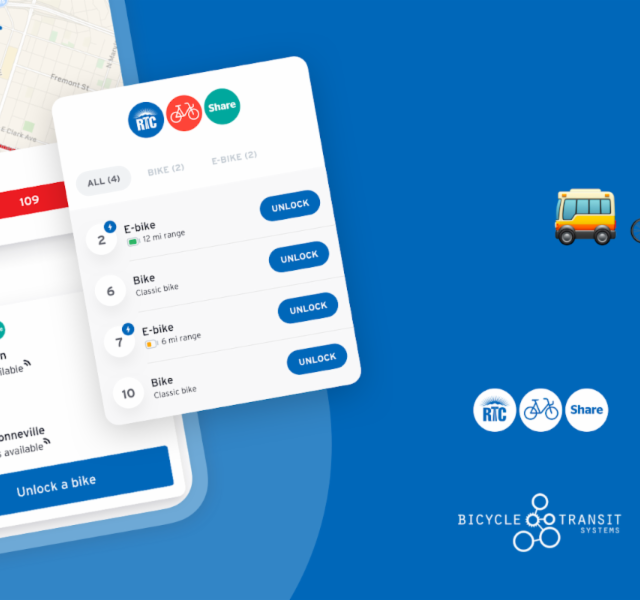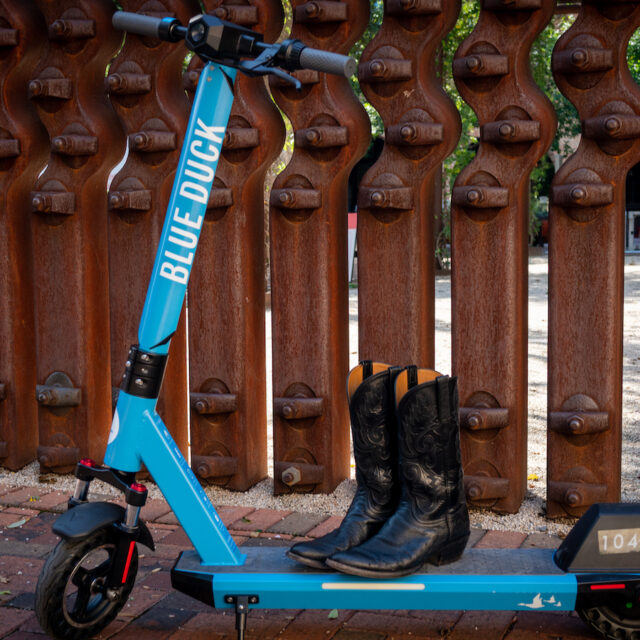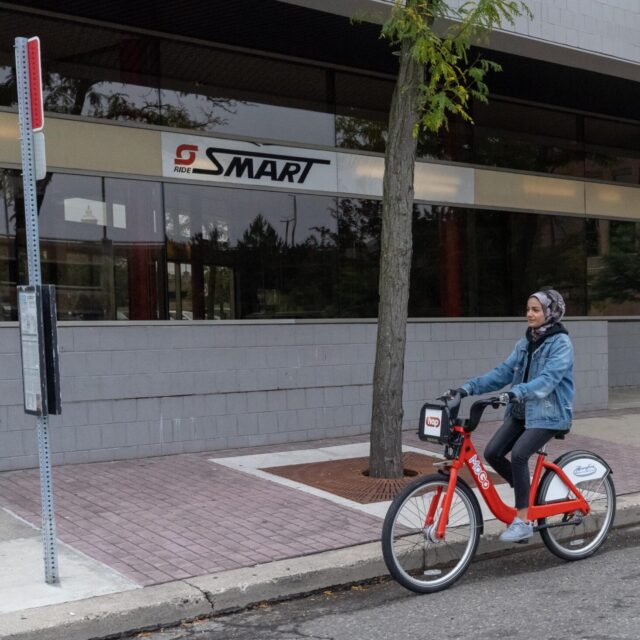Xiang Yan Wants To Make Micromobility Better
by Kiran Herbert, Communications Manager
May 12, 2021
The Chinese-born researcher wants to make public transit and shared micromobility work in tandem.

Xiang “Jacob” Yan grew up in China, moving from a rural village to a bigger city when he was 10, and finally, the large metropolis of Nanjing for college. There, Yan chose to study urban planning, which in China, is essentially engineering. Once he began working, however, he soon grew disillusioned with how little power he had to effect change. Wanting to enter academia and to learn how a democratic society functions, Yan chose to enroll in a master’s program in urban and regional planning at the University of Michigan.
Upon arriving in the U.S., Yan experienced multimodal culture shock. “As a person who grew up in China, who had a lot of options other than cars, I struggled a lot in the U.S.,” says Yan, who couldn’t afford an automobile. “When I started my Ph.D., I wanted to study how to improve transportation for people who don’t want to rely on cars, including myself.”
Yan has now been in the U.S. for about eight years and is currently an incoming research assistant professor at the University of Florida, where he received another master’s in engineering. As a planner and engineer, Yan doesn’t just try to identify problems but rather, actively find solutions. By working closely with communities and public entities, Yan hopes to help them make context-aware, data-informed decisions towards a more sustainable and equitable future.
We spoke with Yan about his work to improve public transit by promoting its integration with micromobility, what cities can do to effect change and what he sees as the biggest transportation obstacle facing the U.S.
 A Conversation with Xiang “Jacob” Yan
A Conversation with Xiang “Jacob” Yan
BBSP: Recently, you’ve been focusing your research on Washington, D.C. What have you learned there?
I chose to focus on D.C. because it’s a city that’s very different from most of the country. It has more mobility options for people, it was a pioneer in embracing e-scooters and it has developed policies to figure out how to make e-scooters work. That, and also the availability of data from the District Department of Transportation, attracted my attention.
What I focus on in the D.C. micromobility project is how e-scooters and [dockless] e-bikes have interacted with existing public mobility options, including public transit and bike share. The key question that drew my attention was: How do these devices complement the existing options, or do they just compete with existing modes? I’m figuring out if micromobility can offer last-mile and first-mile connectivity, and potentially fill the gaps of public transit or station-based bike share.
What I’ve found is that since D.C. has such an extensive transit network and a robust bike share system, there’s little room for e-scooters to really fill a service gap—most parts of the city have already been covered by the existing options. But there are some places that don’t have very good transit services or bike share services where e-scooters could be deployed to enhance mobility options for people who are not well-served by the existing options.
Are e-scooters being deployed in those areas? Why not?
The truth is, the e-scooter companies haven’t really done that because those places tend to be lower density and concentrated with lower-income populations. Since the demand would be low, there’s little incentive for these companies to set up there. Another reason is the existing policy does not incentivize the e-scooter companies to do that. Currently, e-scooter companies face a lot of regulations but there aren’t enough “carrots,” or incentives, to have them figure out how to serve underserved areas. That’s the main takeaway.
How do we create systems that are complementary and do benefit low-density areas and low-income individuals?
From my perspective, the first thing we can do is to empower the cities to make good use of data to understand who the existing services are serving. From there, they could identify places that public transit services are less adequate and bike share systems are not as robust. Once they find those gap areas, then they can have policies, such as requiring the e-scooter companies to place a certain proportion of their vehicles in those areas. Cities can also incentivize these companies to comply with this policy by allowing them to deploy a larger number of vehicles or reduce the fees they charge these companies.
In addition to regulations on e-scooters and e-bikes, I think cities need to have enough incentives in place, and also, they need to have the technology, the data platform, to monitor if the micromobility companies are really doing what they’re supposed to.
Don’t many cities already have equity policies in place?
Yes, many cities require e-scooter operators to place a certain percentage (such as 20%) of their vehicles in predetermined priority zones or equity zones. But oftentimes, these policies are not really enforced. Cities just don’t have any sort of mechanism to monitor if the companies are compliant with the policy or not. So I think they need to develop an analytics platform to monitor that. And also, as I mentioned earlier, they need to create incentives for the companies to do that instead of adding more regulations.
As far as I know, micromobility companies have not made any profit so far, even though they have increased the price quite a bit over time. If we really want to make these new mobility options work for the public good, then we need to treat them like any other public transportation system, which is heavily subsidized. Also, when cities define these equity zones, they need to have a robust understanding of the existing system to identify service gaps—often, the zones are quite big, as defined by the census geographies, not by an analysis of the existing transportation network. My own research tries to fill that gap.
Right now when cities are defining equity zones, what data are they using?
Mostly they’re looking at census data for income and race/ethnicity. Cities like D.C. and San Francisco have some existing work on identifying priority zones or equity zones, and those criteria tend to look at census data like income demographics, maybe car ownership as well. To my knowledge, no U.S. cities are looking at where there are service gaps in the existing public transportation system. There’s a lot of technical work that needs to be done to define these zones. From an administrative point, how to draw these zones can also be a challenge.
Will placing more micromobility options in these underserved areas fix the problem?
Will it do something? Definitely, it will help. But it’s not enough as a stand-alone policy. The spatial policy of placing e-scooters in underserved neighborhoods needs to be coupled with other policies to promote access. Even though heavily discounted programs are available in D.C. and other U.S. cities—for instance, many e-scooters allow qualified low-income people to ride e-scooters for free for the first 30 min—the number of signups for these programs is low. We don’t even know if people that qualify know about them. It’s the e-scooter companies’ job to promote them, but from their perspective, it makes no economic sense to do that. Like I said earlier, the cities need to incentivize them to do more.
How can different micromobility and transit systems complement each other rather than compete?
There are a few different things that can be done, and some places are experimenting with them, but there are also a lot of hurdles. One strategy is bundled pricing between transit and e-scooter and e-bike use—Orlando LYNX is considering that option. Another would be placing more micromobility vehicles at transit stations where there’s good ridership and providing enough parking space for them. The third thing is to make sure the pedestrian and bicycle infrastructure, protected bike lanes, for example, are available near transit stations so that people can ride e-scooters of e-bikes safely to transit stops.
Are cities moving in that direction?
Many cities are not doing enough to promote the integration of transit and micromobility. Most transit agencies still think they are operators of buses or trains—they don’t go beyond to think how other mobility options can be integrated with transit. I think agencies and transportation leaders that have a vision for the future, who are willing to experiment with new ideas and strategies to promote transit and share-mobility integration, will really improve transportation for residents and travelers in their cities. I hope to see more of that happening in the future.
How do we convince the critics?
I myself struggle with this a bit. Once, on Twitter, I argued with a disability advocacy group that wants to stop e-scooters in all cities. They have valid concerns and I echo some of them, such as e-scooters being misplaced on sidewalks, which harms people with disabilities. There are also child safety concerns. I definitely agree with these concerns but these are issues that can have solutions.
What’s the biggest challenge we’re facing when it comes to micromobility?
I think in general, people are more willing to fight against new mobility options they haven’t seen before. Cars as the default option have been rationalized by their existing presence. The biggest challenge to American cities in the transportation realm is car dependence. Cars create so many problems. The environmental harm of cars also isn’t accounted for in the price drivers pay.
When we think about transportation, we need to have a broader perspective and evaluate the pros and cons of each mobility option. When we hear critics [of micromob], we should hear their concerns, but we should also remind them that the harms are greater from cars, not the new mobility options. Cities have treated micromobility options unfairly in the last century—it’s time to give space back to pedestrians, bicyclists and e-scooter riders.
The Better Bike Share Partnership is funded by The JPB Foundation as a collaborative between the City of Philadelphia, the National Association of City Transportation Officials (NACTO) and the PeopleForBikes Foundation to build equitable and replicable bike share systems. Follow us on Facebook, Twitter and Instagram or sign up for our weekly newsletter. Got a question or a story idea? Email kiran@peopleforbikes.org.



